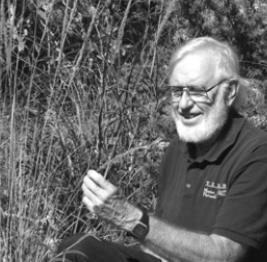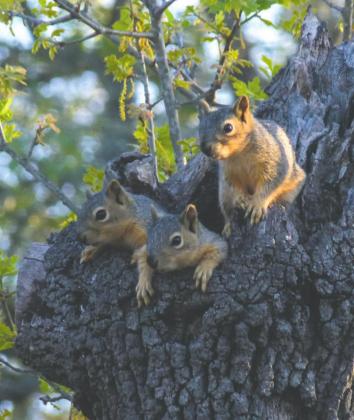Twenty Years in the Life of the “Squirrel Tree”
We started building our house in 2000, and at the time the Blackjack oak, about 30 feet off the south end, was not remarkable, although not quite as big as the other Blackjacks around us. A couple of years after we moved in, we noticed it was showing signs of hypoxylon with the bark sloughing off the upper branches. Then one night in about 2004 or 2005, the entire top broke off in a windstorm about 12 feet up the one-foot diameter trunk.
This left the tree with only one very small branch about half way up. It was obvious that the top of the tree was hollow. Many folks would have cut it down. But we are much more into letting Nature take its course, so we let it stand so if it died it could harbor insects that would make the woodpeckers happy.
Well, it didn’t die. The lone small branch, now having at its disposal the large root system of a much larger tree, began vigorous new growth around the trunk.
Hollows in trees are not uncommon in the Hill Country, and are not often overlooked by our native cavity nesting birds or by our resident squirrels. Sometime around 2008 or so we noticed a squirrel going in and out of the top of the trunk. And a few weeks later we began to see a brood of three baby squirrels. From then on, we referred to it as the “Squirrel Tree.”
At first the little ones would just come up to the top of their cavity and look over the edge to view the world they had so recently entered. Then they would crawl out on the dead limb at the top. Then they would timidly crawl down the trunk a few feet only to quickly return to the safety of their hollow tree.
Eventually, as the tree was budding and leafing out, we could see them tasting a few of the buds, and they even explored the grape vine that was growing up the trunk.
Finally, in less than a month, the triplets had learned to jump from the branches of the Blackjack to the small cedar and from there to climb onto the top of the wire fence, balancing on the wire by flipping their tail from one side to another. And in a couple of more weeks they appeared to be on their own, mostly going their separate ways.
For the next three or four years, we saw a similar activity every spring as a new brood were introduced to the neighborhood. But since then, for some reason, we have never seen any squirrel activity around the tree.
In the meantime, the lone branch growing from the middle of the trunk became larger and larger, almost circling the trunk with green. Then earlier this year in a windstorm, the lone branch broke off, but instead of the branch simply breaking off, it pulled off a huge chunk of the trunk with it. About 3 feet of the side of the trunk where the branch was growing came off, exposing a big part of the hollow trunk.
This then revealed the last squirrel nest which was now several years old, and it also possibly revealed why the squirrels quit using this nest-site—a wasp nest!
So now the “Squirrel Tree” is just a lone bare trunk about 12 feet tall and a foot in diameter with huge hole in the side. I don’t expect to ever see any more growth on this tree.
But, since we fenced the yard right after moving into the house, root sprouts are now allowed to grow rather than be eaten by the deer, and there are numerous root sprouts from this tree within 10 or 12 feet of the old trunk. A few of them are now over six-feet tall. So, in human terms, the old tree will live on through its progeny, even after the trunk finally falls.
I am taking a break from the Friday morning one-on-one visitations about nature at Riverside Nature Center, but I intend to resume my availability there for the 10 a.m. to 12 noon Friday visits beginning September 18.
Until next time…
Jim Stanley is a Texas Master Naturalist and the author of the books “Hill Country Ecology,” “Hill Country Landowner’s Guide” and “A Beginner’s Handbook for Rural Texas Landowners.” He can be reached at <jstmn@ktc.com>. Previous columns can be seen at <www. hillcountrynaturalist.org>.


